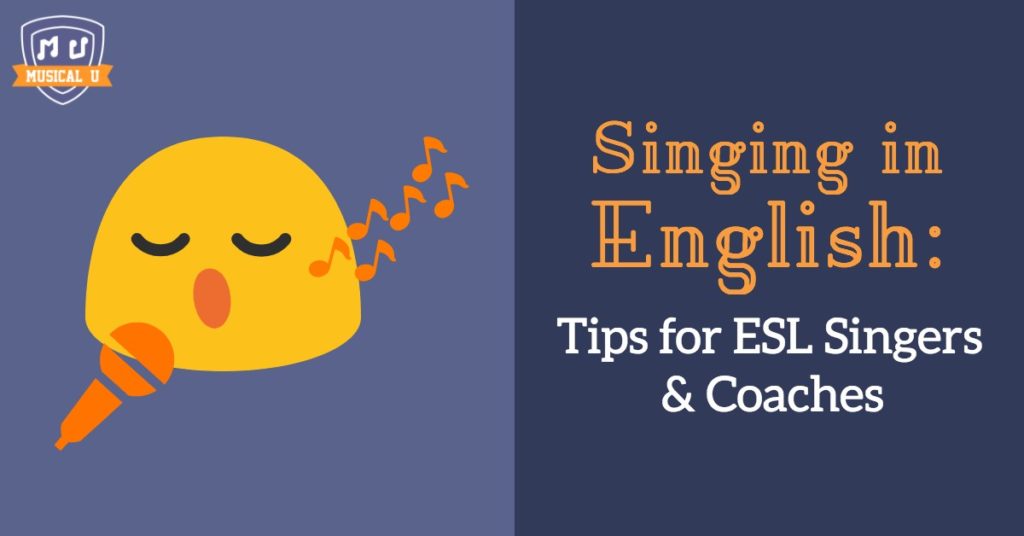From Mexico to Japan, the amount of international performing artists that are singing in English might surprise you. Although time and regular practice can allow ESL singers to become proficient in a non-native language, learning how to sing without an accent can be incredibly challenging and even costly.
Every penny counts when constructing a budget to record vocals in a professional studio.
It’s unfortunate when a foreign artist spends large sums of money to sing in English at a high quality recording studio, only to end up with a lackluster performance with many mispronunciations.
Not all of us are blessed with the ability to speak multiple languages. If you do speak another language then you know how difficult it is to translate ideas and structures in your head and then attempt to transmit that information via a system that is unfamiliar with you.
One of the best ways to efficiently maximize an artist’s financial resources is to invest in a vocal coach that has experience working with international students. The benefit of working with a skilled international vocal coach is obvious to an ESL artist, as they do not want to waste valuable time and money tracking vocals that will be anything less than phenomenal.
Why Sing in English?
Here’s just a few reasons that English as a Second Language (ESL) artists decide to sing pop and rock in English:
- Historically, pop and rock styles have been highly popularized in Anglophone countries, and these styles have been further refined and perfected there
- English has been universally accepted as the global language of pop and rock
- Linguistically, the mechanics of English are considered far more flexible and simple to master compared to many other linguistic systems
- A foreign artist singing in English can vastly broaden their market exposure than if they were to release material in their native language
How to manage singing in English without breaking the budget
Here, I’ll be approaching the issue of singing in English for non-native speakers in two ways:
- Advice to ESL students for learning and improving both on their own and with a coach
- Pointers for vocal coaches with ESL students on understanding what it might be like singing from an ESL student’s perspective
Imagine This:
You have been studying singing and technique for quite some time. Although you are beginning to feel more comfortable, not everything is committed to muscle memory just yet.
Let’s take a moment to inventory all of the things you actually have to do simultaneously in order to sing well:
- Pay attention to your singing breathe capacity; don’t overfill and don’t underfill
- Remember to breathe in from your diaphragm
- Be sure to sing with projection and energy, and let the audience “feel” you
- Execute smooth passaggio transitions
- Maintain supported muscle tension in your cheeks
- Curve your lips properly to execute sharp vowels and consonants
As if that wasn’t enough, now you have to balance projecting energy, while simultaneously maintaining all of the technical aspects.
But wait!
There is one last important thing to do if English is not your native language.
You have to do everything just mentioned while properly enunciating and pronouncing the English words.
For ESL vocalists, working with a coach will make this challenging task perfectly achievable. For teachers, seeing the world through their pupil’s eyes will put some of their challenges into perspective.
Let’s take a look at a few key tools that both ESL students and their coaches can use to make the most out of pronunciation coaching:
- Using positive reinforcement as a driving force for improvement
- Understanding common idioms and metaphors of the English language
- Understanding the sounds present in English that may not exist in other languages
- Using modern technology to enhance the learning experience
Positive Reinforcement
First of all, students: remember that what you’re doing is challenging. The very fact that you’re multilingual and have taken on the task of singing in a foreign language is reason enough to be impressed with yourself!
When practicing, it’s excellent to have goals, but it’s just as important to be gentle, patient, and rewarding with yourself.

Pronunciation improves over time, with continuous practice, and not overnight. Though it’s easy to get discouraged, it’s very likely that your pronunciation is steadily getting better, and the change may just be too gradual for you to notice.
For this reason, it’s helpful to sing in front of or send recordings to your coach or someone else who can track your improvement more objectively and encourage you to keep going. Always acknowledge the progress you’ve made, and celebrate when you meet a goal you’ve set for yourself!
Speaking of encouragement, I have some motivational news for you: singing in a foreign language will speed up the process of learning that language for you. While singing, you are stringing words together in a natural way, while associating them with a melody that you will remember. This works wonders for muscle memory related to pronunciation.
The Vocal Coach’s Role
I personally do not speak any other language fluently, and as a teacher, I’m always quick to remind my students just how impressive their ability to master both singing and the intricacies of a second language really is!
For vocal coaches, it can be challenging to keep into perspective that our natural comprehension of the English language is not the same as our ESL student’s. It’s imperative to avoid being too blunt when honing in on the problem areas.
It may be tempting to roll up our sleeves and attack the areas of concern as quickly and forcefully as possible, but we must be careful to not come off as too harsh to our students.
The student will be much more motivated, and in a space to be more productive, when you are providing steady positive feedback.
Any small improvement in their enunciation should be cause for celebration, as this reminds them that they are making progress, no matter how far off they may appear to be from perfect execution.
Idioms & Metaphors
Though the mechanics of English are relatively straightforward, the language throws a few curveballs with weird expressions that do not mean what they appear to mean.
When we speak in our native language there are certain contextual things we take for granted such as idioms and metaphors.
 English speakers may be used to expressions such as “raining cats and dogs”, but to a foreign singer/songwriter that writes their own lyrics, these expressions are typically not understood well, yet often used incorrectly.
English speakers may be used to expressions such as “raining cats and dogs”, but to a foreign singer/songwriter that writes their own lyrics, these expressions are typically not understood well, yet often used incorrectly.
The particular expression referenced above is what is known as an “idiom”.
The same situation applies to metaphors as well. Metaphors such as “she’s got eyes of the bluest sky” etc… are often times misunderstood and incorrectly applied by ESL students.
Before any performance instruction may begin, it is important to identify these overlooked discrepancies and offer them some assistance to rectify before continuing.
What good is a flawless performance if the core structure and meaning behind the lyrics is confusing or doesn’t make sense?
So if there happens to be an area that stands out a little, do not hesitate to shift focus on lyrical structure. At a very minimum bring it to their attention to correct for next session and do not spend too much time working on enunciating lyrics that will most likely be completely omitted.
Making Sense of Idioms for the ESL Student
To best understand idioms, put them into context! Spend some time asking your coach and other Anglophones around you for explanations and examples of the idioms.
Ask for feedback on your lyrics. Don’t be discouraged if you don’t understand idioms right away, and keep incorporating them into your music!
Unique Sounds in English
When vocal coaches delve into specific areas that require attention, it is important for them to realise that various sounds of the English language are not commonplace in ESL singers’ native languages.
For example, in some languages, when pronouncing any words with an “R” sound, there is a tendency for ESL singers to want to roll the “R” sound with the tip of their tongue.
Whereas in English, we don’t traditionally roll R’s.
In the Persian language for example, English words that begin with a “W” are often times mispronounced with a “V” sound. It can be incredibly challenging to communicate abstract principles like this to an ESL singer to improve their performance. Please review the example to see how I incorporated positive reinforcement as well as detailed focus on the mechanics of the particular area of concern that was causing the issue.
A Tip for Vocal Coaches: Lead By Example
There are many exercises that may seem silly for the student to perform that will assist them with getting the desired results. In situations where I find it is best to request the student to perform an exercise that might appear as awkward, I always like to lead by example, many times exaggerating the awkward element to allow them to feel comfortable knowing that I am not afraid to practice what I preach.
It is up to you as a teacher to come up with creative ways to have the student achieve the desired result. There is no color by numbers approach to teaching as each student may struggle with the same word, but for entirely different reasons. It’s important to understand that each student is unique and learns differently.
Be sure to take a mental inventory of what styles of communication the student learns best from. If you notice that results occur more naturally using one method of explaining and demonstrating over another, then be sure to exploit that technique to maximize results.
Modern Technology
ESL singers: it’s likely you’re already using the internet to help you in your journey to learning English. In addition to countless language-learning platforms such as Duolingo, there are plenty of fantastic resources for learning to pronounce difficult words while singing and sound more like a native speaker.
These include video tutorials, pronunciation guides, and more. Work with your vocal coach to find the supplementary online content that you learn best with.
Using Caution with Online Speaking Tutorials for Singing Applications
One quick point worth mentioning is although there are many helpful online video tutorials that teach ESL students how to perfect their English “speaking”, such as on YouTube, use great caution screening these videos before showing them to the student because some of the instructions may interfere with the same words while singing.
Singing involves many notes during a phrase to flow out freely. Incorporating “speaking” tutorials can at best, confuse your student and at worst, provide discomfort and interfere with their vocal stamina and technique.
The subtle feelings in the throat and tongue movements are many times exaggerated during everyday speaking. When we project while singing, there are slight modifications that must be made to allow a projected vowel or consonant to be executed properly with a nice open and round sound.
When in doubt, leave the speaking tutorials out.
Teaching Remotely
Thanks to the technology of today, vocal coaches can now work with clients on the other side of the world, and international performing artists don’t have to leave their comfort of their home to get personalized, one-on-one vocal coaching from an Anglophone teacher.
There are some caveats to the long-distance teaching approach, of course. It is incredibly challenging to try to provide written instructions to an ESL student to improve problem areas, which is why I am a big advocate of utilizing audio/visual applications.
Although many audio/visual applications are available on the computer, such as Skype and Facebook Video Call, mobile applications that can be used on your cell phone are incredibly convenient and effective.
 In addition to Skype and Facebook Video Call, Apple Facetime, WeChat and WhatsApp are a few others to add to our list of free available audio/visual resources.
In addition to Skype and Facebook Video Call, Apple Facetime, WeChat and WhatsApp are a few others to add to our list of free available audio/visual resources.
Although WhatsApp and similar devices allow you to transmit small recordings back and forth, I find that adding the visual element helps the student to also “see,” in addition to hearing the parts they are performing incorrectly. The added visual element seems to help get the student to achieve the desired results more easily than sound recordings alone. Every student learns differently and your results may vary, so feel free to experiment.
The Journey to Perfect Pronunciation
Non-native singers work incredibly hard to be able to execute all of the mechanics of proper singing technique combined with proper English diction. This is excellent for the coach and the singer alike to keep in mind – singing in English as a non-native speaker is not an easy task, and requires constant focus, dedication, a good ear, and the ability to multitask.
It is essential for both the student and the teacher to use positive reinforcement throughout the coaching process, and to pay attention to any misuse of idioms or metaphors – coaches should encourage singers to continue to use them, even if students feel a little unsteady doing so at first.
Every student learns differently. It is up to your vocal coaches to understand your learning style and adapt accordingly, and it’s up to the student to communicate if something is or is not working.
Lastly, an incredible cultural exchange takes place between the coach and the ESL singer in this scenario. Both parties have the opportunity to learn about a culture other than their own, and expand their respective worldviews.
Personally, it’s a fun little twist of events to allow my students to see the world through my eyes as a teacher, as well as for me to understand what it’s like from their perspective. I sometimes will ask the student to teach me a little phrase in their native language after the lesson to try to sing and speak back to them.
With that, I wish both ESL coaches and ESL singers success as they embark on their collaborative learning journey!
A good vocal coach is an invaluable resource for knowledge and feedback if you are struggling to enunciate and pronounce in English. With some guidance, you can nail your vocal takes, save yourself time and money, and get a better grasp on English.







